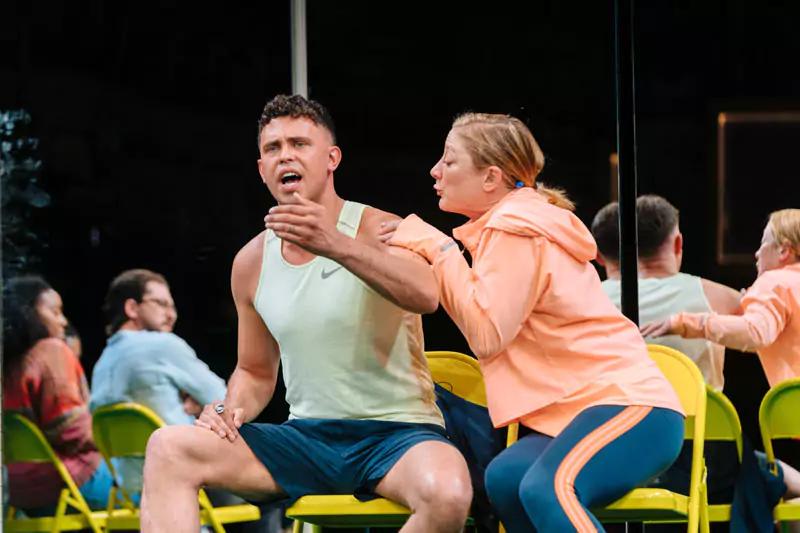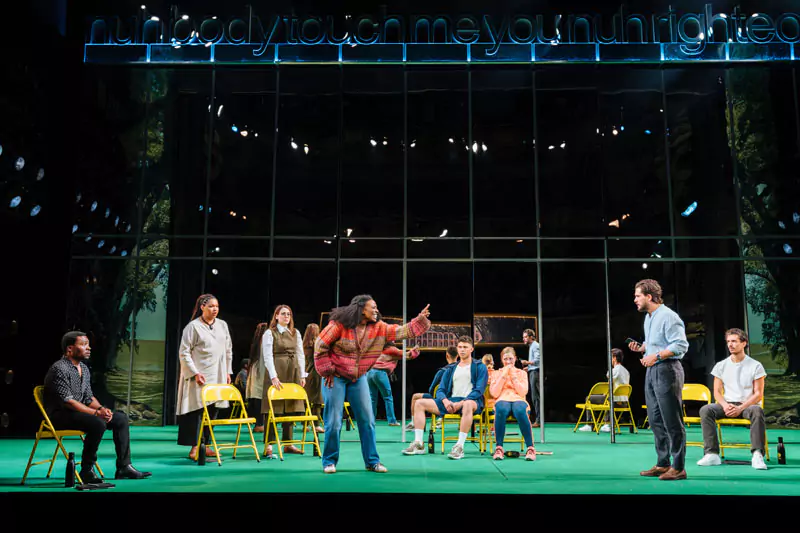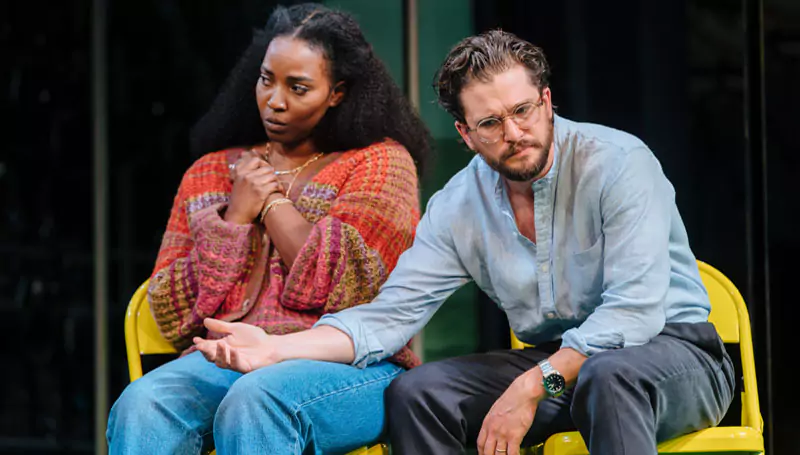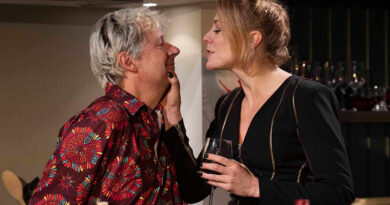“Slave Play” at Noël Coward Theatre
Neil Dowden in the West End
13 July 2024
Jeremy O. Harris’s Slave Play garnered a then record-breaking 12 nominations for Tony Awards, though it didn’t win any. It was already a hotly discussed event even before it transferred from Off-Broadway to Broadway in 2018/19 because of Harris’s introduction of a “black-out” night aimed at black-only audiences. The same controversy has happened here: allocating a couple of performances when underrepresented black audiences specifically are encouraged to come to the theatre to engage with a play that confronts the legacy of slavery has sparked claims that this is divisive and backward-looking. But the real provocation is the content of Slave Play itself which mixes together sensitive issues of race, sex, power, and identity with visceral directness.

Aaron Heffernan and Annie McNamara.
Photo credit: Helen Murray.
In the McGregor Plantation in Virginia we see separately the sexual interactions of three interracial couples. Dressed as a slave, Kaneisha is ordered to eat a cantaloupe melon off the floor by whip-bearing overseer Jim who becomes sexually aroused by her submissive behaviour despite his misgivings. Mistress Alana demands that her mulatto footman Philip play “Negro” music rather than Beethoven on his fiddle, then penetrates him with a dildo in gender-role reversal. Black overseer Gary dominates indentured worker Dustin and orgasms when he licks his boots but then breaks down in tears.
However, when Kaneisha insists on calling Jim “mastah” he stops and says “Starbucks” – which turns out to be the safe word for their BDSM race play as an alarm goes off and the modern-dressed Patricia and Teá enter to end the activities. They are therapists hosting “antibellum sexual performance therapy” for black clients who are no longer able to feel erotic pleasure in their relationships with their non-black partners due to socio-historical reasons. In the follow-up group therapy session the clients and the therapists – who also have difficulties in their interracial relationship – try to dig out the roots of their problems but end up in heated arguments. The shockingly violent short final act involving Kaneisha and Jim closes the play on a murkily ambivalent note.
It’s a clever idea of Harris’s to start off with slavery-era scenes which are then revealed to be sexual role-playing, as period fantasy is interrupted by contemporary reality. Of course all the clues are there: the exaggerated accents and movements of the participants, the cliché-ridden scenarios, the use of pop music like Rihanna’s “Work” on the soundtrack. A lot of it is very funny, as is the satirizing of the academic jargon that the therapists use in their analysis of the clients’ behaviour and feelings. But the middle act – which is over-wordy and goes on for too long – unravels a whole can of worms including racial trauma, white privilege, obsessive-compulsive disorder, and low self-esteem. Harris certainly knows how to push buttons on delicate, even taboo subjects, but the play feels like an imaginative cathartic exploration rather than a sensationalized psycho-drama.

Olivia Washington and Kit Harington (foreground).
Photo credit: Helen Murray.
Slave Play – which is slightly reminiscent of Branden Jacobs-Jenkins’ 2014 play An Octoroon in its deconstruction of racial stereotypes – made Harris’s name but it has taken a long time to reach the UK. His second play Daddy: A Melodrama (which also deals with sexual role-playing and the unequal power dynamics of an interracial relationship, here in the art world) arrived first, staged successfully at the Almeida in 2022. His polarizing work is likely to offend some people – and indeed a few left during the press night of Slave Play – because of its bold, yet playful, in-yer-face approach to elemental matters of race and sex. For once, trigger warnings are probably necessary for Slave Play which can be disturbing as well as provoking uneasy laughter but, with no safe word, it is a compelling journey into the dark human psyche.
Almost all of the creative team from the original US run are involved in this West End production. Director Robert O’Hara maintains the play’s entertaining edginess through an unbroken two hours. Clint Ramos’s set features a mirrored back wall in which characters sometimes pose and which reflects the audience so that our reactions are also under scrutiny, while props such as a four-poster bed emerge on mechanical extensions. Dede Ayite’s costumes shift from pre-Civil War dress to modern casual wear. There are some effective lighting changes from Jiyoun Chang, while composer/sound designer Lindsay Jones adds to the disconcerting ambience.
Half of the original American cast are joined by four British actors, with committed performances across the board. Olivia Washington’s frustrated Kaneisha feels that her desire to confront her neurosis is not supported by her English husband Jim (given a Southern American accent in the first act by Kit Harington) who puts his own discomfort first. Aaron Heffernan’s mixed-race Philip identifies with his black heritage more when in an “illicit” liaison with Annie McNamara’s “Southern belle” Alana. Fisayo Akinade’s Gary resents the overstated claims of racial discrimination by his Latino lover Dustin (James Cusati-Moyer). And Chalia La Tour’s African-American Téa also feels her situation is not fully recognized by her white-passing girlfriend Patricia (Irene Sofia Lucio), who has both black and Hispanic roots. The various tensions in these relationships are finely balanced on a knife edge.









